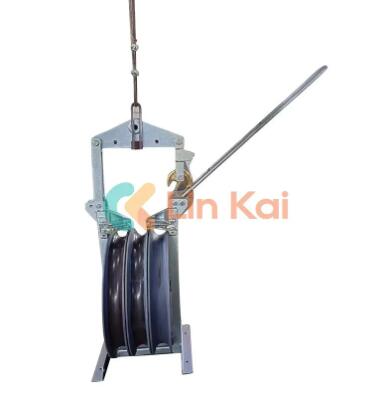Understanding Stringing Blocks for Helicopter Stringing
2024-08-14
Introduction
Stringing blocks play a crucial role in the construction and maintenance of overhead power lines, especially when using helicopters for stringing. These specialized blocks are designed to handle the unique challenges of helicopter stringing, ensuring efficiency, safety, and precision. In this blog, we will delve into what stringing blocks are, their components, and how they are utilized in helicopter stringing operations.
What Are Stringing Blocks?
Stringing blocks are pulley-like devices used to guide and support conductors during the installation of overhead power lines. They are typically made from high-strength materials like aluminum or galvanized steel, ensuring durability and resistance to weather conditions. The blocks are designed to reduce friction and prevent damage to the conductor as it is pulled through.
Components of Stringing Blocks
1. Sheaves: The rotating wheel or drum that guides the conductor. Sheaves are usually made of aluminum or nylon and are designed to minimize friction.
2. Frame: The outer structure that holds the sheaves in place. It is typically made from lightweight yet robust materials to withstand the load without adding excessive weight.
3. Swivel Hooks: These allow the block to rotate freely, accommodating the movement of the conductor and helicopter during the stringing process.
4. Safety Latches: To secure the conductor in place and prevent it from slipping out of the block.
Why Helicopter Stringing?
Helicopter stringing is used in rugged or hard-to-reach areas where traditional methods would be too time-consuming or dangerous. It is also preferred for minimizing the environmental impact, as it reduces the need for extensive ground access.
How Are Stringing Blocks Used in Helicopter Stringing?
1. Preparation: Before stringing begins, the blocks are attached to the transmission towers at specific intervals along the line's route.
2. Stringing Process: A pilot guides the helicopter along the route, pulling the conductor through the stringing blocks. The blocks allow the conductor to move smoothly without sagging or getting damaged.
3. Tensioning: Once the conductor is in place, the blocks ensure that it remains under the correct tension as it is secured to the towers.
Conclusion
Stringing blocks are indispensable tools in helicopter stringing operations, providing a safe and efficient way to install conductors on overhead power lines. By understanding the components and functionality of these blocks, operators can ensure successful stringing operations with minimal risk and maximum precision.



